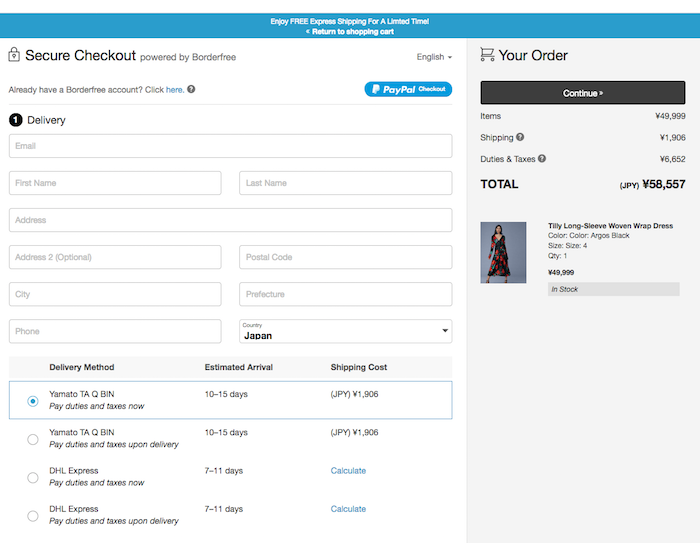Cross-Border Ecommerce: GDPR + Other Factors for Your Global Takeover
As of May 25, 2018 a new law will go into play for retailers in cross-border ecommerce: GDPR. It stands for General Data Protection Regulation, and it aims to protect the privacy of individuals’ digital data in the European Union and the United Kingdom. Yet, not only will GDPR effect retailers based in these countries, it will also apply to retailers with customers living in these countries. (Even just a few!) Today we’re going to outline the facts of GDPR and offer insight into how it may effect ecommerce retailers moving forward.
“No matter what, don’t go it alone.” Felipe Arajuo, DVF.com
We’ll also look at other challenges–and their solutions–in preparing for cross-border ecommerce. We’re inspired to share after attending Think Globally, Sell Locally in NYC, where retail experts discussed critical factors in launching international online sales.
Felipe Arajuo, Senior Director of Ecommerce for Diane Von Furstenberg and one of the event panelists, gave a key piece of advice to retailers planning to go global: “No matter what, don’t go it alone.”
At Command C, we 100% support his words. Here we’ll give an overview of considerations for cross-border ecommerce. Then when you’re ready to expand internationally, let’s plan your customized strategy together.
Related: Ecommerce Metrics & Goal Setting
Challenge: How do I handle customer information, esp. in light of GDPR?

To recap, GDPR is the new data privacy law that takes effect in the European Union and the UK on May 25th of this year. As described by Shopify’s Data Protection Officer, Vivek Narayanadas, GDPR “specifically gives people the right to access, correct, delete, and restrict processing of their data.”
The experts at Magento have also recently written about the upcoming changes: “‘Personal data’ is a vague term, and GDPR’s definition is about as broad as it gets. Under the regulation, any information that could be used to identify a person in any way, even indirectly, is covered. That means names, email addresses, photos, ID numbers, and financial info are all included. So, too, are IP addresses, social network posts, and web-based cookie data.”
Note: GDPR also requires that retailers inform customers of any data security breach within 3 days. Both Shopify and Magento recommend that retailers discuss their current level of compliance with an attorney.
So, putting these ideas together, GDPR refers to a very broad definition of personal data and gives people the right to control their data as they see fit. For instance, if a shopper wants a retailer to delete his contact information, the retailer has to comply or else be fined. (The fines are hefty–approximately $20 million USD or 4% of global revenue, whichever is higher.) To comply with GDPR, retailers with customers in these countries will want to review how their current programs (3rd parties included) handle customer data.
GDPR will bring about change, and ultimately, we think it’s a good thing. We want customers everywhere to feel like they have control over their data and that it’s secure. This will lead to greater consumer confidence in online shopping.
Solution: Customer Service Opportunity of GDPR
Looking at GDPR from a customer service standpoint, the new regulation will ask retailers to create greater incentives for shoppers to share their personal data. Shoppers will need clear reason to opt-in. But this isn’t the worst thing in the world–it means retailers need to relate to customers as people, not data.
How can we do this? Now, more than ever before, it will be essential to build a relationship with your shoppers. Think about new ways to engage such as through customized discounting or product subscriptions. Customers will share their information, if they believe it will lead to a more tailored experience for them. With GDPR, the law requires that retailers are transparent in acquiring customer data. Now it’s up to retailers to extend an inviting reason why customers should share their information. For more on this, here’s Command C’s Quick Start Guide to Ecommerce Personalization.
Challenge: Where do I begin selling internationally?

At Imagine 2017, Magento’s premier annual event, presenters made the case that, much like domestic ecommerce has grown in the past ten years, cross-border commerce will increase in the next ten. Similarly, Shopify says global ecommerce sales will more than double from 2015-2020. With this kind of opportunity ahead, where does a retailer begin?
Solution: Look to your site analytics. Different platforms display user geography in various ways. In Google Analytics, for instance, you can learn where your shoppers come from by clicking on Audience > Geo > Location. To understand how Google displays this information, see the photo above. It’s showing the audience location in real-time. For this retailer, it would be wise to start with Canada, as Canadians already make up 18% of the site traffic.
This merchant should also consider Japan and South Korea. Yet, keep in mind, they’ll have to update the site, hire customer service reps, etc. to handle customers in these languages. If they’re not ready to expand into different languages, then Australia could be their next option. Traffic volume is one piece of data to examine; retailers need to know their sales conversion rates, visit duration, traffic trends, etc. by country, too.
Also, retailers will want to study the level of ecommerce activity in the countries they’re considering for cross-border ecommerce. South Korea, for example, has a high rate of ecommerce purchasing, accounting for 11.3% of all 2017 retail sales in the country. Continuing with the example above, Japan was at 6.2% in 2017. With all other things being equal, this retailer would want to explore South Korea first.
Challenge: How do I show a unified brand across different countries?

Turning back to Felipe Arajuo from Diane Von Furstenberg, he raised this challenge at last month’s event. He described how owning the look and feel of DVF across the world was one of the most the important achievements to date in their cross-border ecommerce.
Solution: As you think about international expansion for your ecommerce business, take some time to peruse DVF.com as if you were shopping from various countries. (Btw, it’s such a beautiful site!) They maintain the same product imagery and descriptions, in English, whether the shopper plans to have her purchase sent to India or Peru.
DVF effectively sets customer expectations based on their country of origin. For example, when someone selects that she’s viewing from Japan, a pop-up appears to assure her that she’ll see prices in Japanese Yen, duties and taxes will be calculated at checkout, she’ll get low shipping rates, and no landed costs. (Landed costs refer to “last mile” charges; in other words, the shopper won’t have unexpected costs in the leg of the shipping.)

Challenge: How do I handle international shipping, taxes, duties?

Solution: Turning again to the DVF example, they’ve partnered with Borderfree to offer country-specific currency payment options, including duties and taxes. In the DVF checkout for Japan, they present four different options, each one varying in the payment of taxes and duties and shipping time for the purchase. As a result, the shopper can compare shipping time vs. price, etc. As we toured various international shopping experiences on the site, we were always given a range of options for each country. Super helpful!
At last month’s event in NYC, another company, Flow Commerce, presented. They’ve been in business for three years and offer similar solutions to Borderfree. The founder said he started Flow when he saw that prices and taxes weren’t localized online. He also strongly encouraged retailers to sell their products with the duties already paid. In other words, don’t wait until delivery for the customer to pay the duties, otherwise retailers could be facing costly returns.
On a final note about international currencies, shipping and more, we’ll quote Command C’s Lead Tech, Tiffany, “If you can think of it, we can do it.” Every challenge has its development solution.
In conclusion, cross-border ecommerce is one of the most important paths forward for retail business growth. As we’ve shown, it’s not without it’s challenges, but that’s why we’re here. Let’s work together to get your ecommerce store selling internationally.
